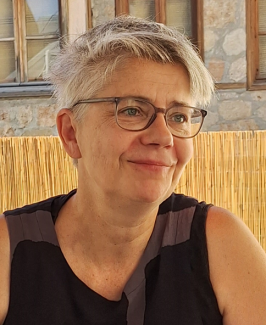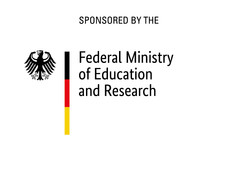
Organisationseinheit
ROCEEH
Senckenberg Forschungsinstitut
Senckenberganlage 25
60325 Frankfurt am Main
Germany
Curriculum Vitae
Main research interests
- Climate and Vegetation history
- Quantification of vegetation parameters and terrestrial palaeoclimate
- The regional impact of global palaeoclimatic changes
- The influence of environmental changes on early human expansions
- Plant food resources and their availability in different landscapes
Academic background
since February 2008 scientific researcher at Heidelberger Akademie der Wissenschaften in research project “The role of culture in the early expansions of humans”
2011 Habilitation (Palaeontology), Faculty of Science, University of Tübingen
2006 – 2008 research assistant at Senckenberg Research Institute, Department of Palaeontology und Historical Geology, working group Climate and Environment
2005 – 2006 research assistant at the Institute of Geosciences, University of Frankfurt
1999 – 2005 research assistant at the Institute of Geosciences, University of Tübingen
1998 Dissertation in Palaeontology (Dr. rer. nat.), University of Tübingen
1991 Diploma in Geology and Palaeontology, University of Kiel
Ausgewählte Publikationen und Vorträge
Publications
Casas-Gallego, M., Postigo-Mijarra, J.M., Sánchez-de Dios, R., Barrón, E., Bruch, A.A., Hahn, K., Sainz-Ollero, H. (2025): Changes in distribution of the Iberian vegetation since the Last Glacial Maximum: A model-based approach. Quaternary Science Reviews 351, 109162. DOI: 10.1016/j.quascirev.2024.109162.
Puspaningrum, M.R., Anwar, I.P., Hertler, C., Hölzchen, E., Krüger, S., Hascaryo, A.T., Reschke, J.-O., & Bruch, A.A. (2024): Living in Sangiran: A Spatial Reconstruction of Hominin Environment in Java at 1 Ma. Earth History and Biodiversity, 2024, 100001, ISSN 2950-4759: DOI: 10.1016/j.hisbio.2024.100001.
Utescher, T., Bruch, A.A., Mosbrugger, V. (2024): The Palaeoflora Database - Documentation and Data (Version 2024) [Data set]. Zenodo. 10.5281/zenodo.10881069.
Beridze, B., Sekiewicz, K., Walas, L., Thomas, P.A., Danelia, I., Kvartskhava, G., Fazaliyev, V., Bruch, A.A., Dering, M., 2023. Evolutionary history of Castanea sativa in the Caucasus driven by Middle and Late Pleistocene paleoenvironmental changes. AoB PLANT 15, 1–15. DOI 10.1093/aobpla/plad059 (open access)
Casas-Gallego, M., Hahn, K., Neumann, K., Demissew, S., Schmidt, M., Bodin, S.C., Bruch, A.A., 2023. Cooling-induced expansions of Afromontane forests in the Horn of Africa since the Last Glacial Maximum. Scientific Reports 13, 10323. DOI 10.1038/s41598-023-37135-8 (open access)
Hayrapetyan, N., Hakobyan, E., Kvavadze, E., Martinetto, E., Gabrielyan, I., Bruch, A.A., 2023. Middle to late Holocene lake level changes of Lake Sevan (Armenia) – Evidence from macro and micro plant remains of Tsovinar-1 peat section. Quaternary International 661, 3448. DOI 10.1016/j.quaint.2023.03.013
Jarl, J., Bruch, A.A., 2023. Modern phytolith assemblages as indicators of vegetation in the southern Caucasus. Vegetation History and Archaeobotany 32, 561-581. DOI 10.1007/s00334-023-00921-5
Kandel, A.W., Sommer, C., Kanaeva, Z., Bolus, M., Bruch, A.A., Groth, C., Haidle, M.N., Hertler, C., Heß, J., Malina, M., Märker, M., Hochschild, V., Nicholas J. Conard, N.J., 2023. The ROCEEH Out of Africa Database (ROAD): A large-scale research database serves as an indispensable tool for human evolutionary studies. PLoS ONE 18(8), e0289513. https://doi.org/10.1371/journal.pone.0289513 (open access)
ter Schure, A.T.M., Bruch, A.A., Kandel, A.W., Gasparyan, B., Bussmann, R.W., Brysting, A.K., de Boer, H.J., Boessenkool, S., 2022. Sedimentary ancient DNA metabarcoding as a tool for assessing prehistoric plant use at the Upper Paleolithic cave site Aghitu-3, Armenia. Journal of Human Evolution 172. DOI 10.1016/j.jhevol.2022.103258 (open access)
Bruch, A.A., Hahn, K., 2022. Raw or roasted? How fire changed what’s on the menu. In: Giemsch, L., Haidle, M.N. (eds.), Being human. The beginnings of our culture. Oppenheim a. Rhein: Nünnerich-Asmus, 74-80. ISBN 978-3-96176-193-7
Mahler, S., Shatilova, I. & Bruch, A.A. (2022): Neogene long-term trends in climate of the Colchic vegetation refuge in Western Georgia - Uplift versus global cooling. Review of Palbotany and Palynology 296, 104546. DOI: 10.1016/j.revbalbo.2021.104546.
Altolaguirre, Y., Schulz, M., Gibert, L. & Bruch, A.A. (2021): Mapping Early Pleistocene environments and the availability of plant food as a potential driver of early Homo presence in the Guadix-Baza Basin (Spain). Journal of Human Evolution 155, 102986. DOI: 10.1016/j.jhevol.2021.102986.
Bolus, M., Bruch, A., Haidle, M., Hertler, C., Heß, J., Kanaeva, Z., Kandel, A., Malina, M. & Sommer, C. (2021): Durch die Menschheitsgeschichte mit dem neuen ROAD Summary Data Sheet. Archäologische Informationen 43, 413.
Bolus, M., Bruch, A., Haidle, M., Hertler, C., Heß, J., Kanaeva, Z., Kandel, A., Malina, M. & Sommer, C. (2021): Explore the history of humanity with the new ROAD Summary Data Sheet. Archäologische Informationen 43, 413-414.
Bruch, A.A. & Hahn, K. (2021): Roh oder geröstet? Wie Feuernutzung den Speisezettel verändert. In: Giemsch, L. & Haidle, M.N. (eds): Menschsein – Die Anfänge unserer Kultur. Begleitband zur Ausstellung. Mainz: Nünnerich-Asmus, 75-80.
Ghosh, R., Biswas, A., Bruch, A.A., Utescher, T., Sen, I., Paruya, D.K., Guha, A., Sultan-Ul-Islam, M. & Bera., S. (2021): Palaeoclimate estimates based on the late Miocene to early Pleistocene wood flora of the Bengal Basin: an insight into the climatic evolution of the southern Asia. Palaeobiodiversity and Palaeoenvironments 101(1), 141–162. DOI: 10.1007/s12549-020-00467-8.
Henrot, A.J., Bruch, A.A., François, L. & Utescher, T. (2021): Introduction to NECLIME Special Issue - Biodiversity and floral patterns in the course of Cenozoic climate change. Geological Journal 56(2), 613–615. DOI: 10.1002/gj.4075.
Shatilova I.I., Kokolashvili I.M., Bukhsianidze M.G., Koiava K.P., Maissuradze L.S. & Bruch A.A. (2021): Late Cenozoic bioevents on the territory of Georgia (foraminifera and pollen). Georgian National Museum, Tbilisi, Georgia. (Monographie).
Uhl, D., Bruch, A.A. & Utescher, T. (2021): Introduction to the special issue “Palaeobotanical contributions in honour of Volker Mosbrugger”. Palaeobiodiversity and Palaeoenvironments 101(1), 1–8. DOI: 10.1007/s12549-021-00484-1.
Altolaguirre, Y., Bruch, A.A. & Gibert, L. (2020): A long Early Pleistocene pollen record from Baza Basin (SE Spain): Major contributions to the palaeoclimate and palaeovegetation of Southern Europe. Quaternary Science Reviews 321. DOI: 10.1016/j.quascirev.2020.106199.
Haidle, M. N., Bolus, M., Bruch, A. A., Hertler, C., Hochschild, V., Kanaeva, Z., Sommer, C. & Kandel, A. W. (2020): Human Origins—Digital Future, an international conference about the future of archeological and paleoanthropological databases. Evolutionary Anthropology. DOI: 10.1002/evan.21870
Hayrapetyan, A., Bruch, A.A. (2020): Pollen morphology of some species of the genus Quercus L. (Fagaceae) in the Southern Caucasus and adjacent areas. Acta Palaeobotanica 1-42. DOI: 10.35535/acpa-2020-0001.
Altolaguirre, Y., Postigo-Mijarra, J.M., Barrón López, E., Carrión, J.S., Leroy, S.A.G., Bruch, A.A. (2019): An environmental scenario for the earliest hominins in the Iberian Peninsula: Early Pleistocene palaeovegetation and palaeoclimate. Review of Palaeobotany and Palynology 260, 51-64. DOI: 10.1016/j.revpalbo.2018.10.008
Krijgsman, W., Tesakov, A., Yanina, T., Lazarev, S., Danukalova, G., Van Baak, C.G.C., Agustí, J., Alçiçek, M.C., Aliyeva, E., Bista, D., Bruch, A., Büyükmeriç, Y., Bukhsianidze, M., Flecker, R., Frolov, P., Hoyle, T.M., Jorissen, E.L., Kirscher, U., Koriche, S.A., Kroonenberg, S.B., Lordkipanidze, D., Oms, O., Rausch, L., Singarayer, J., Stoica, M., van de Velde, S., Titov, V.V., Wesselingh, F.P. (2019): Quaternary time scales for the Pontocaspian domain: Interbasinal connectivity and faunal evolution. Earth-Science Reviews 188, 1-40. DOI: 10.1016/j.earscirev.2018.10.013
Shatilova, I.I., Kvavadze, E.V., Kokolashvili, I.M. & Bruch, A.A. (2018): Atlas of Pollen of the Georgian upper Cenozoic – Gymnosperms and Angiosperms. Georgian National Museum, Tbilisi, Georgia. ISBN 978-9941-27-348-3.
Ghosh, R., Bruch, A.A., Portmann, F., Bera, S., Paruya, D.K., Morthekai, P. & Ali, S.N. (2017): A modern pollen–climate dataset from the Darjeeling area, eastern Himalaya: Assessing its potential for past climate reconstruction. Quaternary Science Reviews 174, 63-79. DOI: 10.1016/j.quascirev.2017.09.002.
Kirscher, U., Oms, O., Bruch, A.A., Shatilova, I., Chochishvili, G. & Bachtadse, V. (2017): The Calabrian in the Western Transcaucasian basin (Georgia): Paleomagnetic constraints from the Gurian regional stage. Quaternary Science Reviews 160, 96-107. DOI: 10.1016/j.quascirev.2017.01.017.
François, L., Bruch, A.A., Utescher, T., Spicer, R.A. & Spicer, T. (2017): Reconstructing Cenozoic vegetation from proxy data and models – a NECLIME synthesis (Editorial). NECLIME special issue Palaeogeography, Palaeoclimatology, Palaeoecology, 467, 1-4. DOI: 10.1016/j.palaeo.2016.11.043.
Teodoridis, V., Bruch, A.A., Kvaček, Z., Vassio, E., Martinetto, E. & Stuchlik, L. (2017): Plio-Pleistocene floras of the Vildštejn Formation in the Cheb Basin, Czech Republic – a floristic and palaeoenvironmental review. NECLIME special issue Palaeogeography, Palaeoclimatology, Palaeoecology, 467, 166-190. DOI: 10.1016/j.palaeo.2015.09.038.
Maul, L.C., Smith, K.T., Shenbrot, G., Bruch, A.A., Barkai, R. & Gopher, A. (2016): Palaeoecological and biostratigraphical implications of the microvertebrates of Qesem Cave in Israel. Quaternary International 398, 219-232. DOI: 10.1016/j.quaint.2015.04.032.
Utescher, T., Bruch, A.A., Erdei, B., François, L., Ivanov, D., Jacques, F.M.B., Kern, A.K., Yu-Sheng (C.) Liu & Mosbrugger, V. (2014): The Coexistence Approach - theoretical background and practical considerations of using plant fossils for climate quantification. Palaeogeography, Palaeoclimatology, Palaeoecology 410, 58-73. DOI: 10.1016/j.palaeo.2014.05.031
Kirscher, U., Gabrielyan, I., Scharrer, S., Bruch, A.A., Kuiper, K. & Bachtadse, V. (2014): High resolution magnetostratigraphy and radiometric dating of Early Pleistocene lake sediments from Southern Armenia. Quaternary International 328-329, 31-44. DOI: 10.1016/j.quaint.2013.06.010
Bruch, A.A., Sievers, C. & Wadley, L. (2012): Quantification of climate and vegetation from Southern African Middle Stone Age sites – an application using Late Pleistocene plant material from Sibudu, South Africa. Quaternary Science Reviews 47, 7-17. DOI: 10.1016/j.quascirev.2012.04.005.
Bruch full pub until 2019: pdf
Current Projects
-
PlantBITES - A database for Plant Resources in Early Human Environments
 BMBF
BMBFin cooperation with Karen Hahn, Goethe University, Frankfurt/Main
The database PlantBITES is a tool to consider the full range of dominant plant species in different vegetation units, their seasonal availability and their use potential. The database serves to assess the amount and variety of obtainable food (and other) resources that were available to early humans. It also examines the necessary techniques for exploitation and use of plant resources. Such data crucially contribute to answer questions about how early humans with different technological abilities could have used plants in different environments.
-
PhD-project Lisa Schiersch: Potential Paleolithic plant use in the Southern Caucasus – natural availability and cultural ability
in cooperation with Dr. Ivan Gabrielyan (Botanical Institute of the Armenian Academy of Sciences, Yerevan, Armenia)

